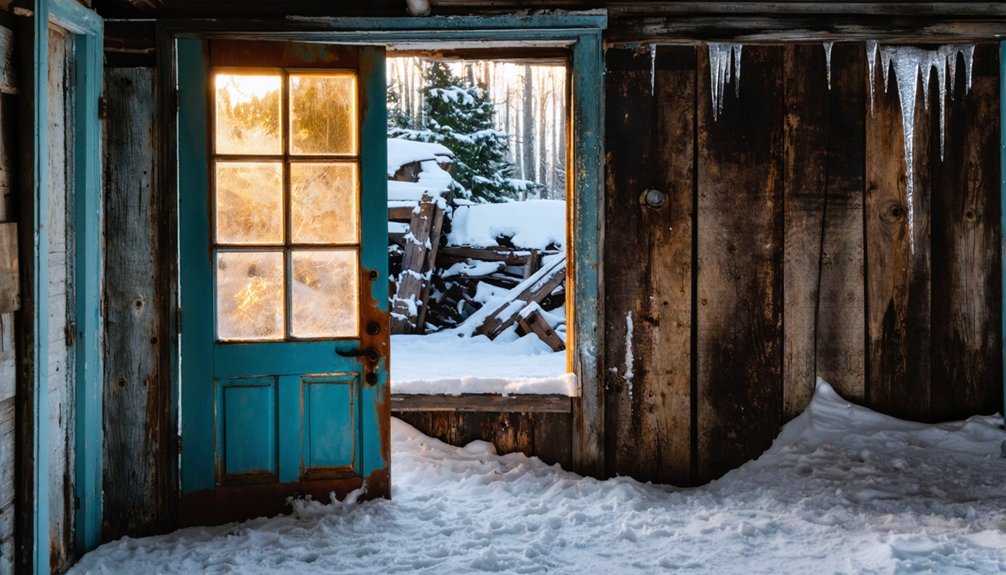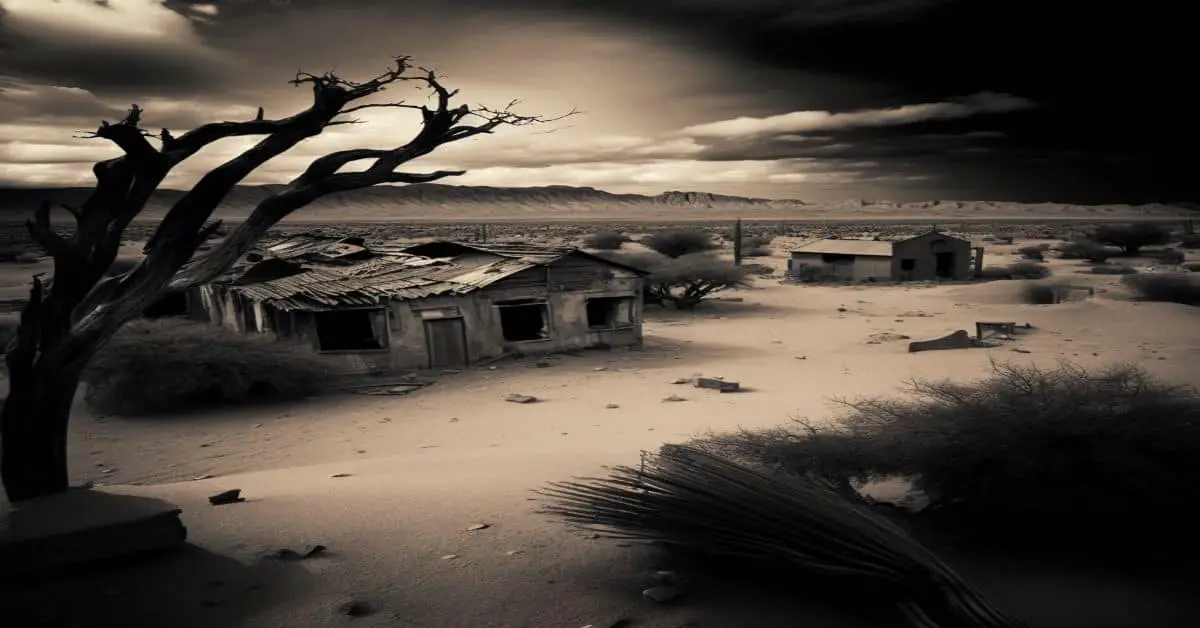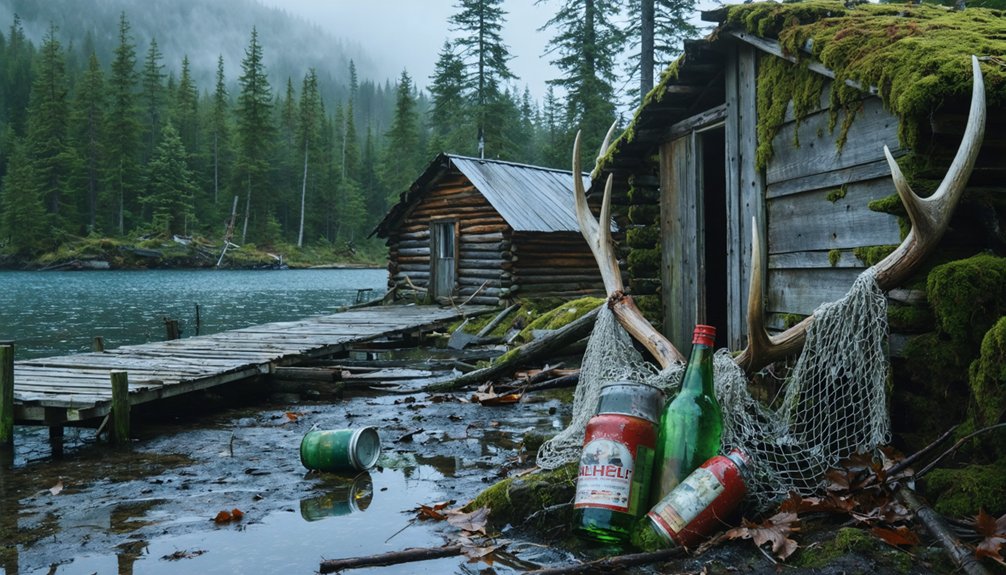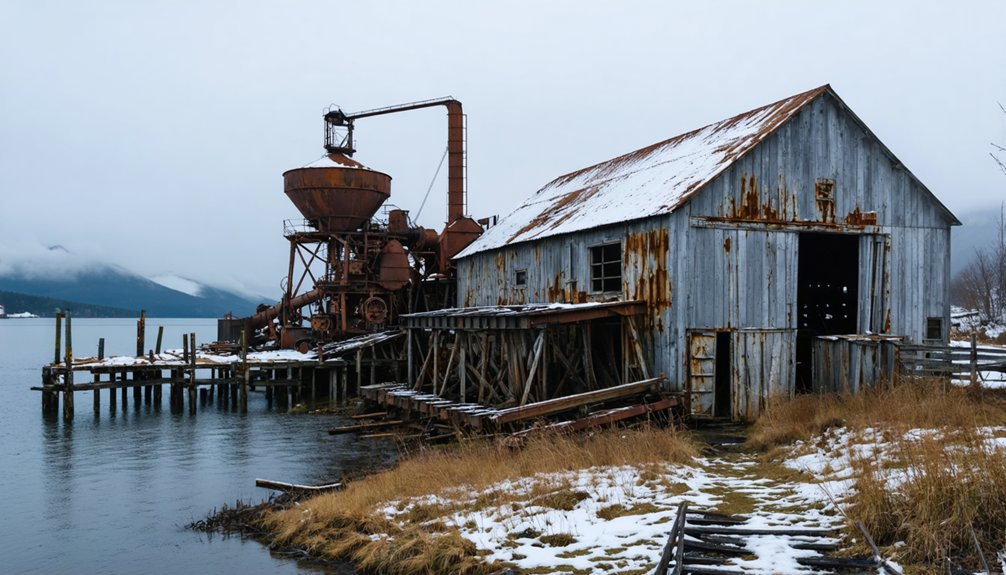You’ll find Dickson’s remnants near the Solomon River Delta, where it emerged as a bustling mining settlement in 1900. Originally an Indigenous fish camp, the town grew rapidly after gold’s discovery, gaining a post office and railroad connection. While copper mining and timber operations flourished briefly, the economic crash of 1907 and harsh Alaskan conditions led to its abandonment. Today, weathered ruins and railroad artifacts tell a fascinating tale of frontier ambition and nature’s reclamation.
Key Takeaways
- Dickson was established during the Alaska gold rush around 1900, initially thriving as a hub for mining, timber, and fishing industries.
- The town’s decline began after the 1907 economic crash and increased competition from the Kennicott Mine.
- Railroad operations ceased by 1913 when a storm destroyed the tracks, contributing to the town’s abandonment.
- Environmental challenges like permafrost thaw and coastal erosion have accelerated the physical decay of remaining structures.
- The site now stands as a ghost town with only weathered remnants slowly disappearing beneath natural vegetation.
The Origins of Solomon Village
Before becoming known as Dickson, the area was originally home to the Fish River Tribe, who used the location as a summer fish camp.
You’ll find the settlement’s earliest documented history under the name “Erok” on maps from 1900, marking the beginning of significant population dynamics in the region.
The original settlement was established at the mouth of the Solomon River Delta, but later shifted to Jerusalem Hill, named after the ancient city where King Solomon built his grand temple.
When gold was discovered in 1899-1900, you’d have witnessed a dramatic transformation of this quiet fishing spot into a bustling hub of activity with the town quickly growing to include seven saloons and numerous businesses.
The settlement history took a pivotal turn as prospectors flooded the area, leading to rapid development including the establishment of essential services like the post office under Otto Weihe’s supervision in 1900.
Cultural Heritage and Indigenous Roots
Before Solomon became a bustling gold rush town, you’ll find its roots in the Native Eskimo settlements that thrived along Fish River’s rich waters.
Like the seasonal fish camps that Tlingit people established throughout Southeast Alaska, Eskimo communities maintained traditional fishing camps and hunting grounds in this fertile region.
You can trace the indigenous presence back thousands of years, as Eskimo communities maintained traditional fishing camps and hunting grounds in this fertile region.
The area’s original inhabitants developed sophisticated cultural practices centered around seasonal subsistence patterns, including fishing, hunting, and gathering activities that sustained their communities through harsh Arctic conditions.
Sadly, the arrival of Russian explorers in the 18th century marked the beginning of significant changes for Alaska’s indigenous communities.
Native Eskimo Settlement Origins
The rich cultural tapestry of Alaska’s Indigenous peoples reveals complex origins in Dickson’s region, with Eskimo populations historically ranging from 60,000 to 80,000 people before European contact. Major Eskimo migrations shaped the coastal regions, with the Northern Archaic tradition appearing 6,500-7,000 years ago, bringing new tools and possibly new peoples.
You’ll find that cultural adaptations were specific to maritime environments, with Eskimo settlements concentrated along the Arctic coastal plain, western Alaska, and Gulf regions. These small village communities typically consisted of 20 to 30 people who lived together and shared resources.
While Dickson itself doesn’t appear in pre-contact settlement records, the surrounding area was home to various Eskimo groups including Inupiaq, Siberian Yupik, Central Yup’ik, and Alutiiq peoples. By 1900, the demographic landscape had shifted dramatically as the U.S. Census reported more white inhabitants than Native Alaskans.
These communities developed sophisticated survival strategies, establishing seasonal settlements based on resource availability and constructing semi-subterranean sod houses for shelter.
Traditional Fish River Life
Life along Fish River centered on rich seasonal salmon runs that sustained Indigenous communities through carefully refined harvesting practices.
You’d find traditional fishing practices perfectly adapted to the river’s seasonal rhythms, using seines, spears, and fish traps crafted from spruce roots and sinew. These methods showcased deep ecological sustainability, allowing selective harvesting while protecting future fish returns. The terminal fisheries approach enabled communities to target specific salmon runs with precision. Like modern-day trollers, they focused on quality over quantity.
The river’s bounty went beyond mere sustenance. When you gathered to fish, you participated in celebrations that strengthened family bonds and cultural ties.
Indigenous fishers applied generations of knowledge to monitor fish health and populations, adjusting their harvest to maintain balance. Their time-tested preservation techniques, from drying to freezing with seal oil, guaranteed year-round food security while honoring their connection to the land.
Cultural Practices and Beliefs
Since time immemorial, Indigenous peoples including the Ahtna, Upper Tanana, Eyak, and Tlingit have forged deep spiritual and cultural connections to Dickson’s surrounding landscape.
You’ll find evidence of their 13,000-year presence at Nataeł Na’, where ancestors established crucial trade routes across the Bagley Ice Field and harvested salmon from the Copper River.
Their cultural storytelling traditions weave together dance, song, and oral histories that express a profound spiritual interconnectedness with the natural world. The communities are organized into Eagle and Raven moieties that guide social structures and marriage practices.
Through totem poles and ceremonial practices, they’ve preserved clan histories and ancestral knowledge. Modern initiatives focused on cultural tourism healing help strengthen and revitalize these traditional practices.
Despite Russian colonization’s disruptions through forced labor and religious conversion, Indigenous communities maintain their resilient cultural heritage.
Today, you can experience their living traditions through the Alaska Native Heritage Center’s programs and cultural tourism initiatives.
The Rise of Resource Industries
Mining operations, timber harvesting, and fishing industries transformed Dickson from a small settlement into a bustling commercial center in the early 1900s, mirroring patterns seen across Alaska as companies like the Alaska Commercial Company established crucial supply networks.
You’ll find evidence of this economic boom in the remnants of old sawmills and abandoned mining equipment, which once supported the region’s resource extraction activities.
The arrival of railroad connections further accelerated Dickson’s growth, creating efficient transport routes for both raw materials and processed goods.
Mining and Timber Operations
Copper’s allure brought prospectors to Dickson in 1898, when the McClellan party discovered significant deposits 180 miles east of Valdez. Legal battles ensued until Judge Wickersham’s 1903 ruling favored the Chittyna Exploration Company, paving the way for expanded mining operations.
You’ll find that mining techniques evolved rapidly, with three-shift operations running around the clock by 1916.
The booming copper industry relied heavily on timber supplies from local logging operations. You needed substantial lumber for everything from mine supports to mill buildings and worker housing.
When copper prices doubled from 12 to 24 cents per pound between 1904 and 1906, mining flourished. However, the crash of 1907 and competition from the higher-grade Kennicott Mine in 1911 eventually led to Dickson’s decline.
Economic Growth Through Fishing
As mining activity waned in Dickson during the early 1900s, commercial fishing emerged as an crucial economic lifeline for the region.
You’d find salmon and herring operations driving the town’s growth, with canneries providing steady employment for locals and indigenous fishermen alike.
The Alaska Packers Association‘s dominance shaped Dickson’s fishing landscape, controlling most of the salmon pack by 1897.
While fishing regulations evolved to protect resources, you could see the industry adapting through various harvesting methods – from traditional fish traps to modern gillnetting.
The implementation of the Magnuson-Stevens Act and creation of regional management councils helped promote economic sustainability, though not without controversy.
Even as herring reduction plants faced competition from Peru’s anchoveta fisheries in the 1950s, fishing remained crucial to Dickson’s economy until its eventual decline.
Railroad Transportation Development
While the fishing industry kept Dickson’s economy afloat, the town’s fate would soon intertwine with ambitious railroad developments across the Seward Peninsula.
In 1902, you’d have witnessed the founding of the Council City and Solomon River Railroad, which established its headquarters in Dickson. This railroad history began with nine miles of track in 1903, expanding to include a 34-mile spur to Penny Creek by 1906.
The transportation legacy, however, proved short-lived. Despite serving both freight and passenger needs, the railroad faced mounting financial difficulties and material shortages.
Operations ceased in 1907, and a devastating storm in 1913 destroyed the remaining tracks.
Today, you’ll find the abandoned locomotives and cars still standing as haunting reminders of this brief era, known as the “Last Train to Nowhere.”
Daily Life in Early Dickson
Living in early Dickson meant adapting to a rugged frontier existence shaped by gold mining’s seasonal rhythms. You’d find yourself among a mainly male population, forging strong community bonds despite the harsh conditions.
Mining life revolved around basic log cabins and temporary shelters, with minimal infrastructure and constant challenges.
Life on the mining frontier meant simple dwellings and makeshift solutions, where survival demanded constant adaptation to harsh realities.
Your daily routine would have included:
- Working your claim during summer months, dealing with physical demands and safety risks
- Gathering essential supplies from traders or hunting and foraging to supplement your diet
- Socializing at makeshift gathering spots, sharing news and stories with fellow miners
- Managing basic needs like hauling water, chopping firewood, and maintaining your shelter
Medical care was scarce, and you’d rely heavily on home remedies and mutual aid from neighbors during emergencies.
Myths and Local Folklore
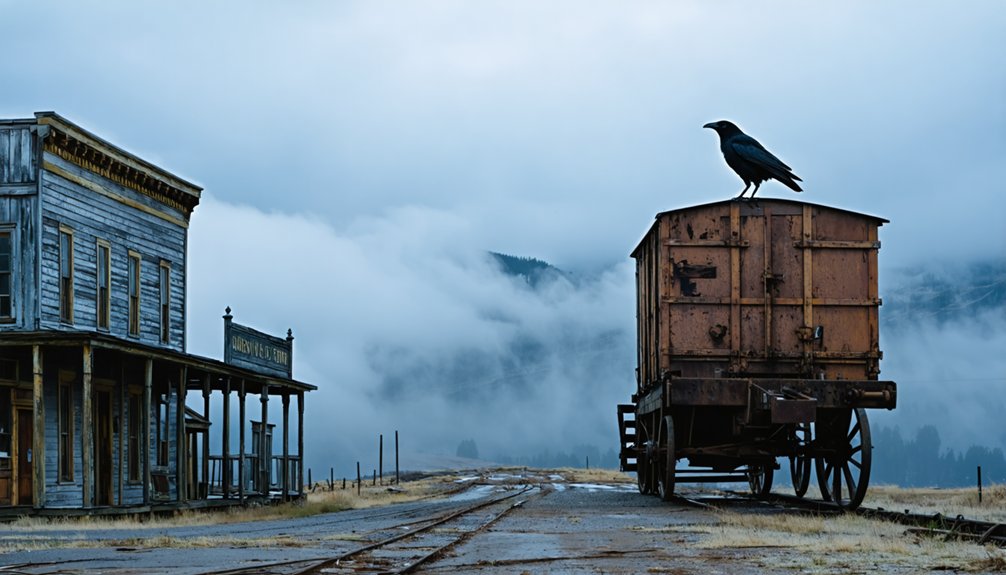
Deep within Alaska’s rugged wilderness, Dickson harbored its own collection of supernatural tales and mysterious legends.
Like many ghost towns across Alaska, you’ll find stories of ghostly sightings and unexplained phenomena woven into the local folklore. The region’s vast, untamed landscape created perfect conditions for tales of mythical creatures, similar to the Hairy Man of Portlock or the elusive Nantinaq.
You might hear whispers of the Little People, mischievous beings said to roam the abandoned buildings, or accounts of strange whistling sounds echoing through the empty streets at night.
These stories mirror the rich tapestry of Alaskan folklore found throughout the territory, particularly within the infamous Alaska Triangle, where countless unexplained disappearances have occurred over the years.
Environmental Challenges and Isolation
As climate change accelerates across Alaska, Dickson faces unprecedented environmental challenges that threaten its remaining infrastructure and historical legacy.
The region’s environmental degradation has intensified due to rapid warming, creating a cascade of destructive effects that test community resilience.
You’ll find these critical challenges affecting the area:
- Permafrost thaw and coastal erosion combine to create “usteq,” causing catastrophic land collapse.
- Sea ice loss removes natural coastal barriers, leaving shorelines vulnerable to storm surge.
- Compromised waste facilities and water systems pose serious health risks to nearby communities.
- Limited transportation access due to damaged infrastructure isolates the region during emergencies.
These environmental pressures continue to reshape Dickson’s landscape, making it increasingly difficult to maintain any remaining structures or preserve its historical significance.
The Great Migration Period
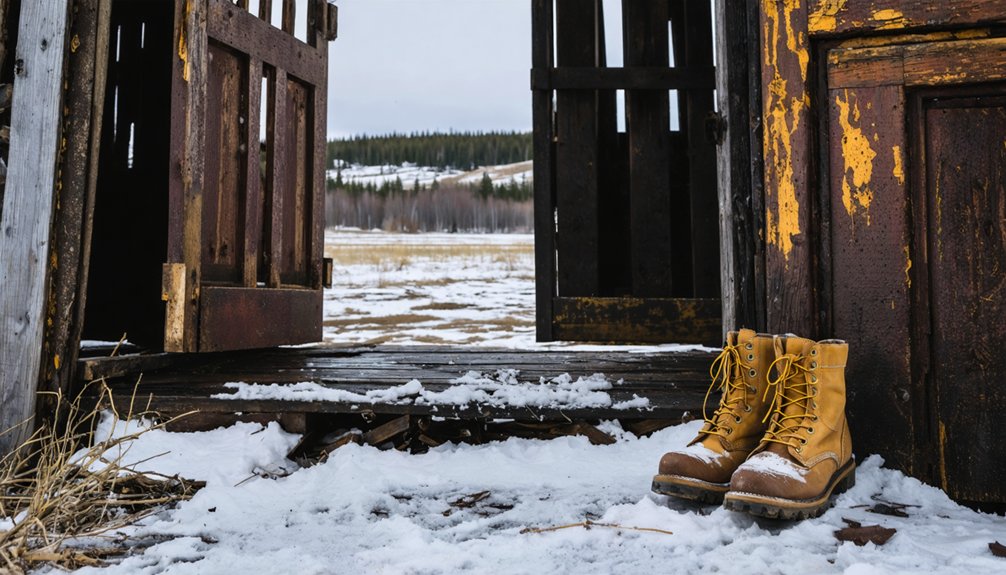
While today’s environmental challenges threaten Dickson’s remaining structures, the land itself holds an ancient story of human migration spanning tens of thousands of years.
You’re standing on ground that witnessed multiple waves of migration patterns, as early peoples crossed the Bering Land Bridge 15,000-30,000 years ago. These first hunter-gatherers adapted to the harsh Arctic environment, following game and developing survival strategies that would define Alaska’s indigenous cultures.
The region’s archaeological record reveals at least three major Siberian migrations, each bringing distinct genetic markers and cultural adaptation techniques.
Successive waves of Siberian peoples crossed into North America, each group carrying unique genetic signatures and ways of surviving.
These movements weren’t random – they were driven by climate change, food availability, and social dynamics. When you explore Dickson today, you’re walking through land that served as a vital gateway for humanity’s expansion into the Americas.
Legacy of Abandonment
Once a bustling frontier settlement, Dickson now stands as a stark reminder to Alaska’s boom-and-bust resource economy. The abandonment impacts are evident in the skeletal remains of buildings and the quiet reclamation by wilderness.
You’ll find Dickson’s legacy manifested in several distinct ways:
- Economic vulnerability led to its downfall when resource depletion and rising costs made operations unsustainable.
- Physical decay accelerated under harsh Alaskan weather, leaving roofless structures and rubble as evidence to its past.
- Cultural artifacts and remnants provide valuable insights into frontier life and resource-dependent communities.
- Natural reclamation continues as wildlife habitats expand and vegetation gradually erases traces of human settlement.
The town’s story mirrors countless other Alaskan communities that rose and fell with their dependence on single industries.
Modern-Day Ghost Town Status
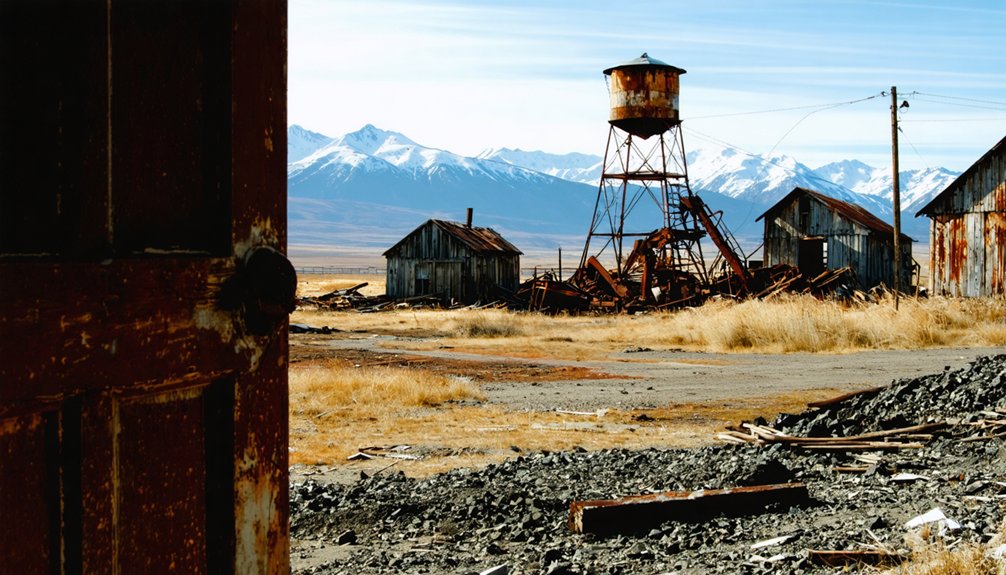
Today, Dickson stands completely abandoned on the east bank of Solomon River, with no permanent residents recorded since the early 20th century.
The ghost town dynamics reflect the harsh reality of Alaska’s boom-and-bust settlements, with nature steadily reclaiming what humans left behind.
You’ll find most structures have succumbed to the elements, deteriorating under the intense Arctic climate cycles.
The site’s historical significance as a railroad town has largely faded, with no preservation efforts in place to maintain its remnants.
The remote location, coupled with limited accessibility, has left Dickson largely forgotten.
What remains is typical of abandoned Alaskan settlements: a weathered footprint slowly disappearing beneath natural vegetation, subject to permafrost shifts and seasonal erosion.
Frequently Asked Questions
Are There Any Remaining Structures Still Standing in Dickson Today?
You won’t find any abandoned buildings standing there today, as no historical preservation efforts were made. The site’s structures have completely vanished, leaving no visible traces of its past.
What Was the Peak Population of Dickson During Its Most Prosperous Period?
You’ll find that Dickson’s economy peaked around 1910 with approximately 50 residents, primarily supported by railroad activities rather than mining operations. The population never grew substantially beyond this number.
Can Visitors Legally Explore the Dickson Ghost Town Site?
You’re skating on thin ice without clear legal information. Due to limited exploration regulations and visitor safety concerns, it’s best to seek local permissions before attempting any site visits.
Were There Any Documented Murders or Suspicious Deaths in Dickson?
You won’t find documented murders in official records, though local legends hint at mysterious disappearances. Without concrete evidence, these stories remain unverified tales from Alaska’s rugged frontier days.
What Transportation Methods Were Used to Reach Dickson During Its Active Years?
You’d reach Dickson primarily by steamship along rivers, while pack animals and wagons navigated inland mining routes. Though railroad access was planned, it never fully materialized for this remote location.
References
- https://www.chipchick.com/2024/04/this-eerie-alaskan-village-was-abandoned-and-became-a-ghost-town-in-1950-as-legend-states-that-a-large-hairy-beast-was-responsible-for-dozens-of-deaths-and-disappearances
- https://www.youtube.com/watch?v=Cz0IGc2Uy0E
- https://motorcyclemojo.com/2015/09/alaska-ghost-towns/
- https://en.wikipedia.org/wiki/List_of_ghost_towns_in_Alaska
- https://www.youtube.com/watch?v=J8TOUJ3y0o8
- http://wikimapia.org/6873665/Solomon-Dickson-AK-Ghost-town
- https://www.villageofsolomon.org/history
- https://en.wikipedia.org/wiki/Solomon
- https://solomonbedandbreakfast.com/our-history
- https://www.alaska.org/detail/solomon
